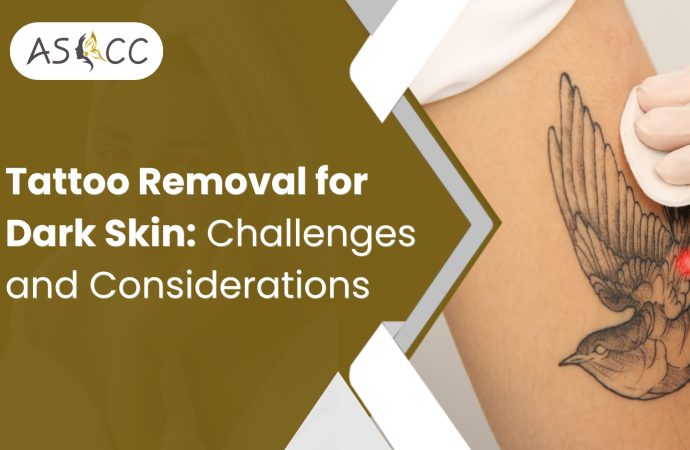Introduction Removing body art is rarely straightforward, and the colour of the skin complicates matters even more. Technicians often point to darker complexions as the trickiest group to treat. A patient with richly pigmented skin needs to consider these challenges carefully before signing any consent form. Understanding these obstacles beforehand often leads to better decisions
Introduction
Removing body art is rarely straightforward, and the colour of the skin complicates matters even more. Technicians often point to darker complexions as the trickiest group to treat. A patient with richly pigmented skin needs to consider these challenges carefully before signing any consent form. Understanding these obstacles beforehand often leads to better decisions and, ultimately, better outcomes. If you’re searching for the Best Tattoo Removal Treatment in Jaipur, it’s essential to choose a clinic that has the expertise to handle the complexities of darker skin tones for the best results.
Modern clinics boast a remarkable array of technologies, yet none of them treat every skin tone equally. The extra melanin in darker skin interacts with various wavelengths of light in unpredictable ways. Lasers that excel on ivory or olive skin can fall short, burn, or leave ghostly outlines on ebony or mahogany dermis.
Why Tattoo Removal is Different for Dark Skin
Heat is the enemy, and darker skin absorbs more of it than lighter skin ever could. Excessive energy turned loose during a pass can create blisters, scars, or that maddening post-treatment haze. For that reason, a device fine-tuned to the melanin profile of the patient often makes the difference between success and regret.
Selecting a Skin-Safe Removal Protocol
The choice of tattoo-erasure technology is particularly consequential for individuals with richly pigmented skin. Procedures that ignore this specificity often yield unfortunate sequelae, including permanent textural changes and atypical colouration. A clinician who privileges skin safety alongside ink clearance will preserve the dermatological baseline while meeting the patient’s cosmetic goal.
Catalogue of Erasure Techniques
Tattoo abolition strategies span topical acids, surgical excision, dermabrasion, and multiple laser variants. Familiarity with the mechanistic underpinnings of each alternative empowers the patient to weigh outcomes, downtime, and dermal risk before consenting.
1. Laser Regimens and Pigmentation
Q-switched or picosecond lasers remain the gold standard because fleeting light bursts shatter dye granules into sizes the lymphatics can escort. Standard protocols falter on dark skin, however, since excess melanin magnetises stray photons, occasionally prompting thermal injury. Adaptive settings, informed by pulse duration, wavelength selection, and skin-staging scoring, are critical to tilt the risk-benefit axis toward safety and efficacy.
2. Dermabrasion and Surgical Excision
Dermabrasion and surgical excision remain viable alternatives to laser therapy. The former mechanically abrades the epidermis in successive passes, while the latter involves physically excising the tattooed dermis. Both approaches can be substantially more invasive. Operators must acknowledge their heightened propensity to produce noticeable, permanent scarring, a concern that is especially pronounced in individuals with higher eumelanin content. After dermabrasion, patients may discover a mottled texture; excision invariably leaves a linear scar that sometimes widens during the healing phase.
Removal Complications in Darker Phototypes
Attempts to eradicate pigment from dark skin involve a distinct set of hurdles. Surgeons and dermatologists list the following difficulties when counselling affected individuals.
Hyperpigmentation Incited by Thermal Stimuli
Hyperpigmentation frequently complicates the removal process in darker phenotypes. The selective photothermolysis relied upon by lasers can inadvertently trigger excess melanin synthesis in response to the localised heat. Ill-timed or overly aggressive settings may leave a post-treatment island of skin significantly darker than its surrounding tissue. This discrepancy can persist long after any ink particles have been cleared.
Uneven Results Due to Skin Tone
Higher concentrations of melanin in darker dermal layers selectively absorb laser energy, often interfering with the expected clearance pattern of ink particles. Clinicians may therefore observe pronounced variability in an individual session, leaving patches where the pigment remains stubbornly visible. Tight treatment intervals and precise calibration of fluence and pulse duration can temper that unpredictability.
1. Sensitivity to Treatments
The heavier melanin shield not only modulates effectiveness but also heightens nociceptive response to the thermal pulse, translating into sharper, more sustained discomfort. Recovery timelines tend to elongate as well, inviting secondary risks such as post-inflammatory hyperpigmentation or textural scarring. Meticulous aftercare coupled with vigilant oversight is indispensable in these cases.
2. What to Look for in a Tattoo Removal Clinic
Locating a facility equipped to address the unique challenges of darker phenotypes demands both technical acumen and hands-on experience.
3. Choosing the Right Equipment for Dark Skin
Q-switched Nd: YAG systems remain the benchmark for melanin-rich skin, allowing selective targeting of tattoo pigments while largely sparing the epidermal substrate. Providers should be transparent about their platform lineage and ideally present treatment charts or clinical outcomes that reflect work on similarly pigmented individuals.
4. Importance of Experienced Professionals
Sharing the office with a technician who knows how dark skin absorbs light can save a patient months of trial and error. Not every laser operator has that familiarity, so selecting a clinic with a proven track record on melanin-rich dermis is not merely prudent- it is the baseline for reliable results.
5. Personalised Treatment Plans
One tattoo may be mostly blue, another entirely red, and a third pastel grey; no single pulse pattern works across that spectrum. A provider who writes bespoke protocols based on colour, age of ink, and individual dermal response gives the ink an honest fight while protecting the surrounding tissue.
How Laser Tattoo Removal Works for Dark Skin
A short burst of concentrated light shatters pigment particles into fragments small enough for the body to absorb; that principle does not change with skin tone. Darker skin, however, reflects more light and absorbs it at different depths, which alters the risk profile and treatment mechanics.
1. Wavelength and Laser Type
Lasers locked to longer wavelengths-typical for Nd: YAG devices-penetrate deeper and sidestep the uppermost layers of the dermis about 80 per cent of the time. That depth control is critical because it minimises collateral heating while still puncturing the ink cloud. This advantage dictates much of the technical literature on safer removal in highly pigmented skin.
2. The Operational Physics of Melanin in Laser Therapy
Melanin, a dermal pigment that imparts photometric variation across human skin types, demonstrates a strong absorption peak in the visible spectrum. High melanin density, as found in richly pigmented skin, heightens the risk of inadvertent thermal damage when clinical parameters are miscalibrated. Hence, practitioners must fine-tune pulse duration and fluence to preferentially excite dispersive tattoo particulates with minimal collateral insult to surrounding tissue.
Clinical Protocols for Dark-Skinned Subjects
Effective laser-facilitated tattoo erasure within intensely pigmented populations hinges on a triad of procedural vigilance: preparatory assessment, session-based oversight, and deliberate recuperative guidance.
1. Preparatory Dermal Conditioning
Cutaneous readiness for laser engagement is achieved through consistent moisturisation and stringent ultraviolet avoidance, thereby minimising baseline erythema. Operators also verify that compromised epithelium, such as fissures or acute dermatitis, is definitively resolved before treatment initiation.
2. Recuperative Management Following Laser Exposure
Post-procedural healing demands a regimen that incorporates emollients to mitigate transepidermal water loss and sterile cleansing to deter microbial colonisation. Persistent sun blockade remains crucial; even transient ultraviolet exposure can precipitate hyperpigmented sequelae. Adherence to facility-generated aftercare directives substantially curtails long-term scarring risks.
3. Managing Expectations and Patience
Tattoo-removal technology is steadily improving, yet progress still unfolds gradually on richly pigmented skin. Fainting at a months-long series of appointments before anything obvious appears is almost a rite of passage. Steady upkeep and long-haul patience are the hidden twin currencies that usually pay off in the end.
4. Risks and Side Effects of Tattoo Removal for Dark Skin
Every medical intervention carries a freight of risk, and laser removal is no exception- waiting room clinicians won’t want to sugarcoat that warning. Darker dermal melanin can react in ways fairer skin does not, so caution creeps in sooner than confidence for most operators.
Scarring
Burning the ink out of flesh, whether with Q-switched or picosecond gear, still pushes living tissue into an alarmed state. If energy settings stray too high or the wound gets irritated post-session, tidy patches can harden into tell-tale scars. Credentialed technicians usually monitor spot response closely to dial back before that permanent mark shows up.
5. Skin Texture Changes
The very rhythm of tissue healing sometimes leaves a tattooed zone slightly more rugged or unexpectedly bumpy. Socio-cultural discolouration and textural flip-flops- some people call it cobblestoning- may linger long after the last light pulse fires. Observing proven after-care and sticking with seasoned operators reduces the odds of that rough souvenir.
6. Finding the Best Tattoo Removal Treatment for Dark Skin
Jaipur clinics wielding the most contemporary technology for pigmented skin rarely spring up overnight. Prospective patients ought to scour reviews and inquire about specific laser platforms before booking a 20-minute consultation. Spotting operators who can demonstrate consistent success on similar skin shades often tips the decision in favour of science over haze.
7. Researching Local Clinics
User-generated feedback, an online portfolio, and an in-person consultation compose the trifecta of clinic vetting. Commit the hours early; tattoo removal is both permanent and financially substantial.
8. Considering the Best Tattoo Removal Treatment In Jaipur
Residents of Jaipur should favour facilities experienced with melanin-rich skin and equipped with cutting-edge lasers, such as Q-switched or picosecond systems. Bespoke treatment plans matter, because one-size-fits-neither to ink nor epidermis.
Conclusion: Your Journey to Clear Skin
Tattoo removal on darker complexions demands methodical evaluation and seasoned practitioners. The right dermatologist can lift unwanted pigment while preserving the skin’s integrity, so due diligence pays immediate dividends. Prospective patients seeking the Best Dermatologist in Jaipur ought to prioritise documented experience with high-melanin skin.
FAQs
1. Can I remove tattoos on dark skin without scarring?
Scarring is not inevitable when technology and technique are appropriately calibrated.
2. How many sessions does tattoo removal for dark skin take?
The course usually spans multiple visits, dictated by ink density, colour palette, and dermal
penetration.
3. Does tattoo removal hurt on dark skin?
Tattoo-removal lasers can feel like a sharp snapping against the epidermis, though topical or local anaesthetics substantially dull that sensation.
4. How long will it take for my skin to heal after tattoo removal?
Typical re-epithelialization occurs within a week or two, yet complete cosmetic recovery may stretch across several weeks, depending on individual physiology.
5. How can I avoid hyperpigmentation after tattoo removal?
Strict sun protection, diligent adherence to aftercare protocols, and early consultation with a dermatologist for topical lighteners can mitigate the risk of post-inflammatory dyschromia.
















